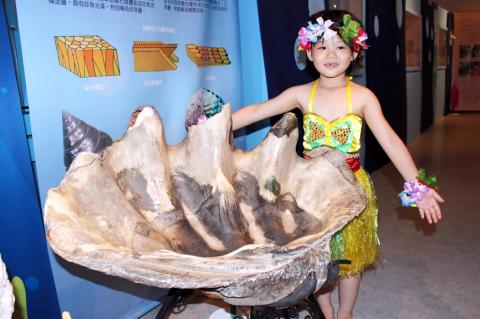Seashell enthusiasts can now see the world’s most valuable and the world’s largest shells, including the Rumphius’ Slit Shell and the giant clams Tridacna gigas — in close detail — along with many other seashell species and shell specimens at an exhibition being hosted at a facility in southern Taiwan.
The Tsai-liao Fossil Museum in Greater Tainan last week launched an exhibition of seashells allowing visitors to view some rarely seen marine forms from more than 300 specimens lent by Taipei’s National Taiwan Museum (NTM).
The exhibition which runs until Sep. 23, also reveals many of seashells’ natural mysteries to the public — such as how they capture the sound of the ocean and how every shell ends up with its own exquisite and unique pattern.

Photo: Lin Meng-ting, Taipei Times
Aside from having a close-up opportunity to observe a multitude of seashells, visitors to the exhibition can also finger the crusty surfaces of a diverse range of sea creatures.
One of the exhibition’s greatest draws is a Rumphius’ Slit Shell, the most precious and rarely found kind of shell in the world, which is valued at about NT$380,000.
“Inhabiting deep waters, the Rumphius’ Slit Shell is the world’s most expensive seashell mainly because of its scarcity, with its shell resembling the shape of a round timepiece and exhibiting long crevices and flame-like patterns on the surface,” said Lai Ching-yang (賴景陽), a member of the NTM’s collections and preservation commission.
Lai added that in 1970 a Taiwanese fisherman dredged up a Rumphius’ Slit Shell off the country’s southeast coast, which was only the fourth one of its kind to have been found worldwide. However, the rare object was procured by an aquarium in Japan at the time, he said.
That makes the Rumphius’ Slit Shell, which is displayed and preserved in Taiwan, a fairly rare and precious marine object, Lai added.
Other focal points at the exhibition include a giant clam, Tridacna Gigas, the world’s largest shell species that can reach up to 1.4m, Lai said, along with a handicraft item made of more than 20,000 small seashells in the shape of the NTM.
Translated by Stacy Hsu, Staff Writer

Taipei and New Taipei City government officials are aiming to have the first phase of the Wanhua-Jungho-Shulin Mass Rapid Transit (MRT) line completed and opened by 2027, following the arrival of the first train set yesterday. The 22km-long Light Green Line would connect four densely populated districts in Taipei and New Taipei City: Wanhua (萬華), Jhonghe (中和), Tucheng (土城) and Shulin (樹林). The first phase of the project would connect Wanhua and Jhonghe districts, with Chiang Kai-shek Memorial Hall and Chukuang (莒光) being the terminal stations. The two municipalities jointly hosted a ceremony for the first train to be used

The Mainland Affairs Council (MAC) yesterday said it is fully aware of the situation following reports that the son of ousted Chinese politician Bo Xilai (薄熙來) has arrived in Taiwan and is to marry a Taiwanese. Local media reported that Bo Guagua (薄瓜瓜), son of the former member of the Political Bureau of the Central Committee of the Communist Party of China, is to marry the granddaughter of Luodong Poh-Ai Hospital founder Hsu Wen-cheng (許文政). The pair met when studying abroad and arranged to get married this year, with the wedding breakfast to be held at The One holiday resort in Hsinchu

Tropical Storm Usagi strengthened to a typhoon this morning and remains on track to brush past southeastern Taiwan between Friday and Sunday, the Central Weather Administration (CWA) said. The storm, which as of 8am was still 1,100km southeast of southern Taiwan, is currently expected to enter the Bashi Channel and then turn north, moving into waters southeast of Taiwan, the CWA said. Because of its rapid speed — 28kph as of 8am — a sea warning for the storm could be issued tonight, rather than tomorrow, as previously forecast, the CWA said. In terms of its impact, Usagi is to bring scattered or

An orange gas cloud that leaked from a waste management plant yesterday morning in Taoyuan’s Guanyin District (觀音) was likely caused by acidic waste, authorities said, adding that it posed no immediate harm. The leak occurred at a plant in the district’s Environmental Science and Technology Park at about 7am, the Taoyuan Fire Department said. Firefighters discovered a cloud of unidentified orange gas leaking from a waste tank when they arrived on the site, it said, adding that they put on Level A chemical protection before entering the building. After finding there was no continuous leak, the department worked with the city’s Department